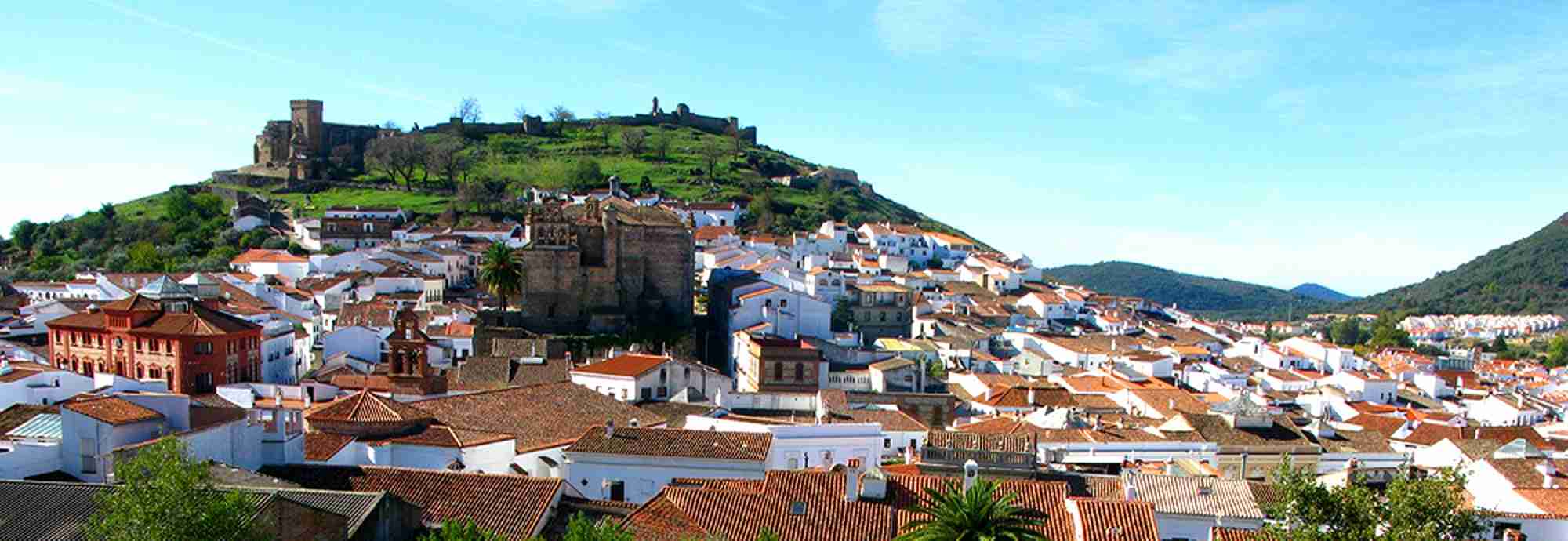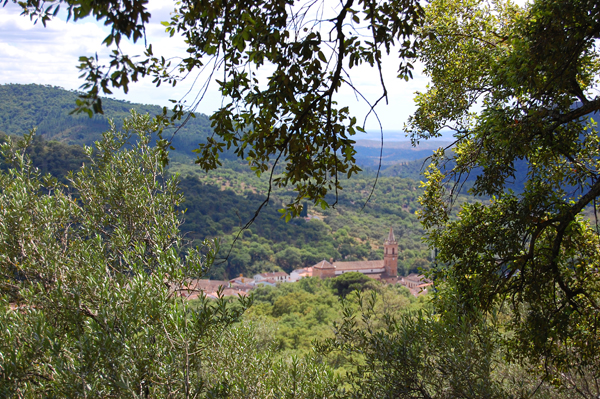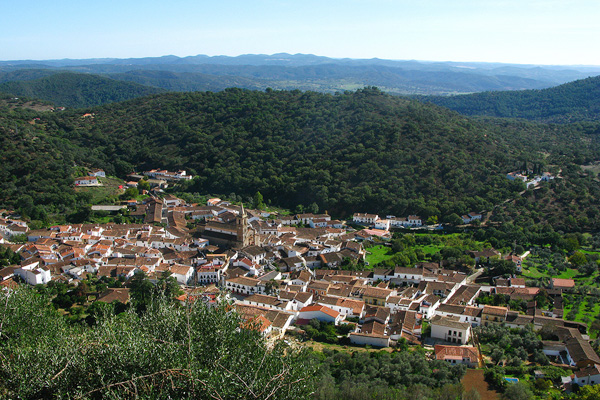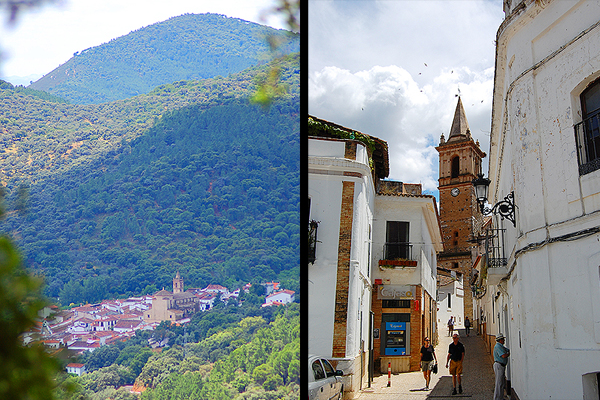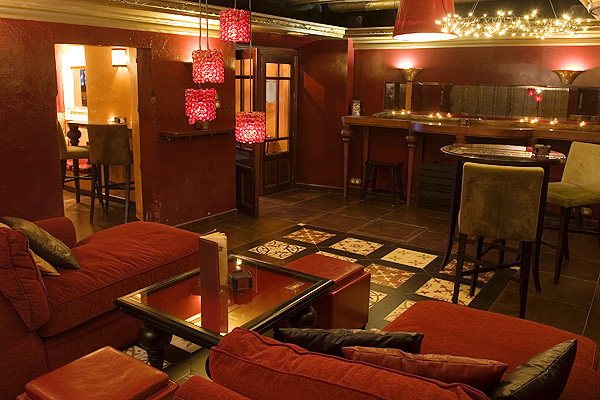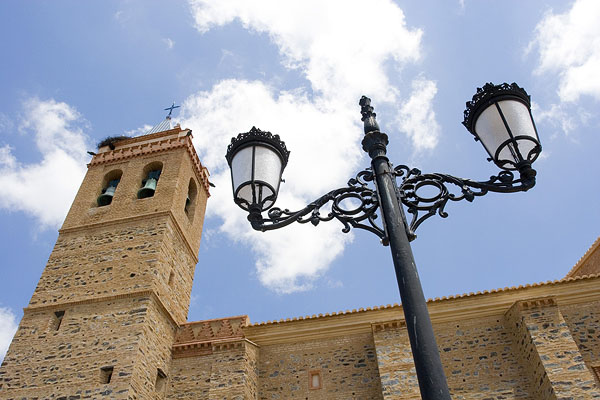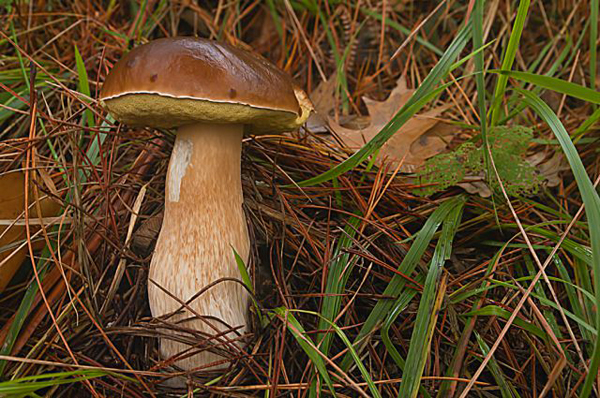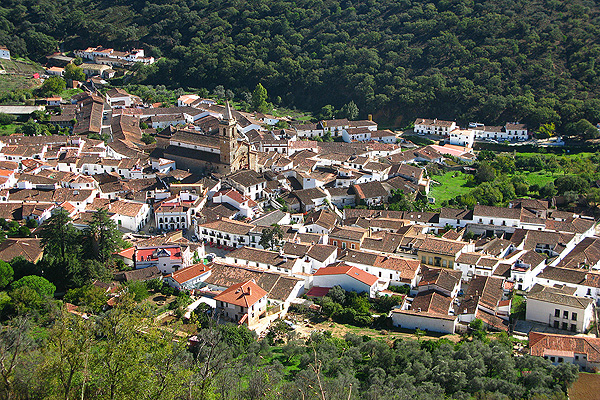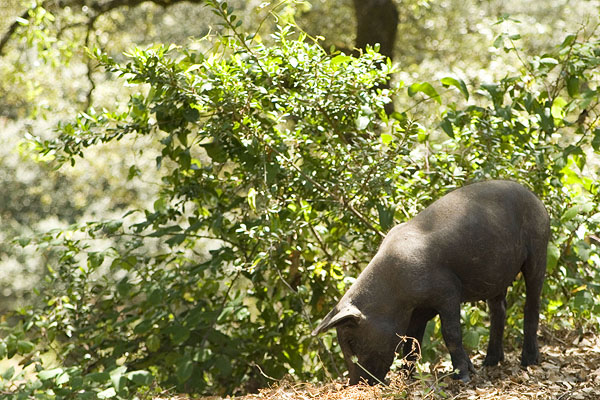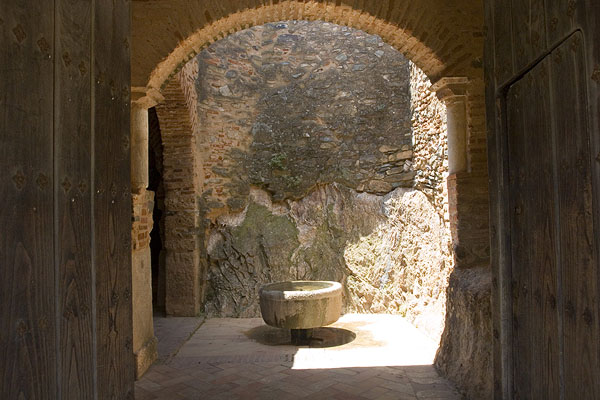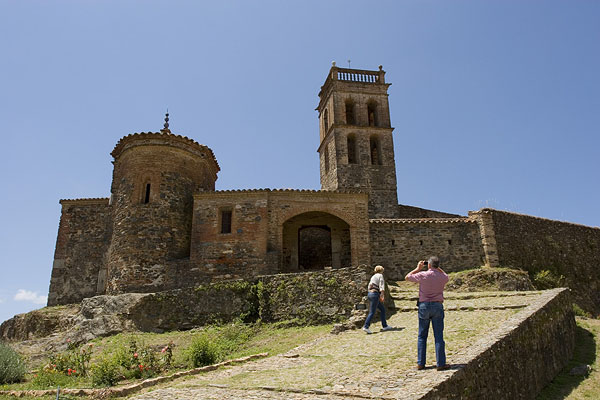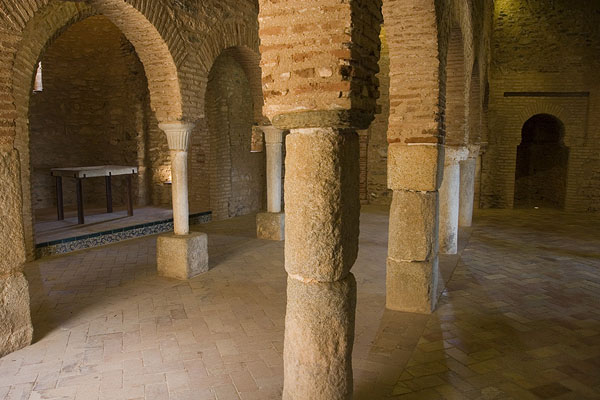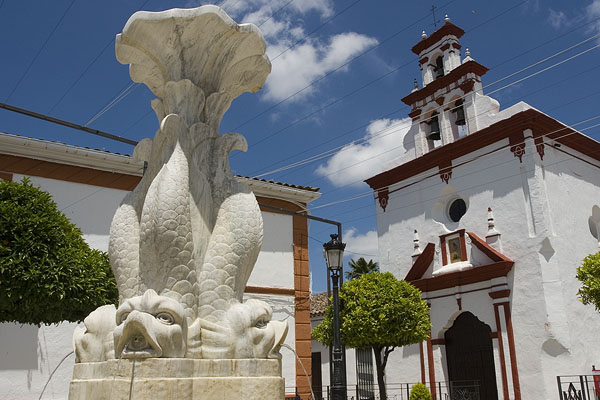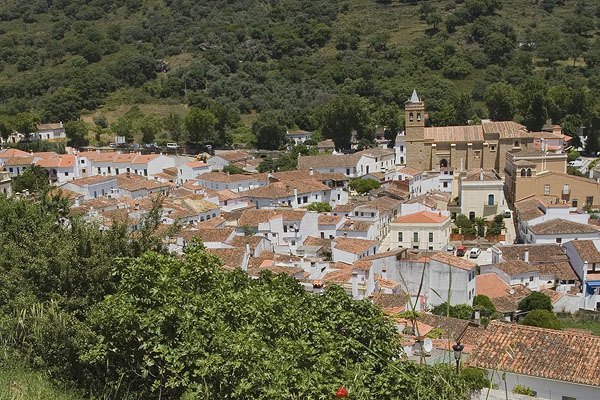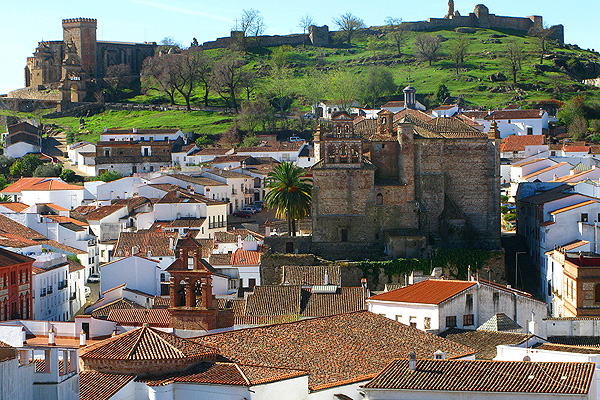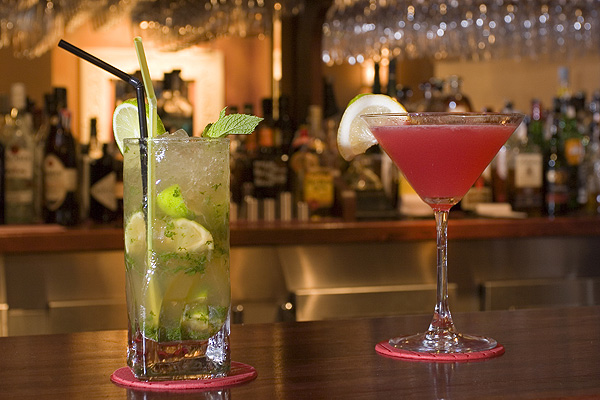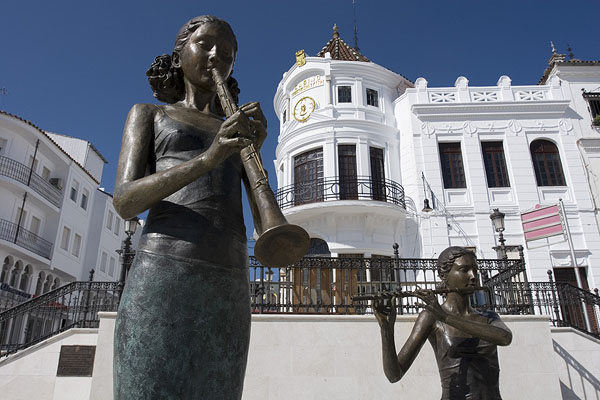Stroll round Aracena town and see good examples of popular architecture. See if you can find medieval arched windows on Calle Francisco Rincón, a Renaissance doorway on Calle Blas Infante, at the corner with Calle Constitución, and a Renaissance corner window on the former House of the Inquisition (Casa de la Inquisición).
Visit the 13th century castle church and the ruins of the Moorish castle on the hill above the town. Only two towers and walls of the original castle remain, but they are amply augmented by the castle church dating from the same period, which still stands. The Knights Templar church has gothic elements and a magnificent Mudéjar tower. Entrance is free of charge.
Don't miss Aracena's famous Grotto! The fascinating limestone caves are a must for visitors. Here "water has written a poem through the silence and slowness of the centuries," extols the flyer to this extensive series of caves with their colourful stalagmites and stalagtites and gentle pools.
The route of 1,200 metres lasts 45 minutes, taking you along walkways and galleries with fantastic and colourful rock formations and clear subterranean pools. Humidity is between 90% and 98%. No photography or touching the rock formations is allowed. Guided visits are in Spanish but the experience is predominantly visual. A geological and mining museum annexed to the Grotto is also open to visitors.
HAM MUSEUM
(Museo del Jamón), very near the Grotto. It records and celebrates all matters to do with the raising of the free-roaming pigs and production of the famed local "black foot" cured ham.
OPEN AIR SCULPTURE MUSEUM
Designed to be walked round, the Museo de Escultura al Aire libre "Andalucía" features 34 works in stone, iron, bronze, aluminium and ceramic by 18 artists, which endeavour to express meaning by means of the abstract. The permanent exhibition was designed to bring contemporary art closer to the public and contribute aesthetically to the San Pedro Square area, the cultural epicentre of Aracena town, where the Grotto is also to be found.
ARACENA'S MAIN SQUARE
The plaza at the heart of the village comes alive in the afternoons with a very Spanish feel to it.
PARQUE DE ARIAS MONTANO
A lovely park, great for family with children, at the bottom of the village.
PANTANO DE ARACENA
Aracena´s reservoir offers lake swimming in summer months. However, it gets busy in summer and can feel overrun at weekends when people turn up to have barbecues, and we are told that the place can then feel rather spoiled. All the same, it may be an interesting option for families with children.
OPEN-AIR SWIMMING POOL
Galaroza, 15 mins from Aracena on the A-433 Portugal road, has a good public swimming pool with a separate kiddies pool. The bar by the pool here serves excellent tapas. Normally open from July to September.
SIERRA DE ARACENA AND ITS VILLAGES
Marvellous Natural Parkland with cork oak forests, streams and paths. Stop and visit the little whitewashed villages, for example: Alájar, Fuenteheridos, Linares, Jabugo (famed not for its beauty but its cured ham), Los Marines, Almonaster la Real with its ancient mosque, and sweet Galaroza in the Murtiga Valley. The nature and character of local villages has changed remarkably little in comparison to the cities of modernized Spain. The people still work the land, keep goats and sheep, and maintain the irrigation channels developed by the Moors. As recently as the 1940s, these doubled as smugglers' trails through the Sierra de Aracena from Portugal, during the time when post-Civil War Spain underwent the harrowing years known simply as "el hambre": hunger.
WALKING SIERRA DE ARACENA
Every one of the small villages in the Sierra has been linked for countless years by caminos reales, paths which wind their way through the countryside. These are all still public rights of way and they make for excellent walking. Along with mule paths and ancient Roman ways, they form part of the network of trails that makes Aracena such terrific trekking country. There are lakes, streams and waterfalls, which invite the visitor to wholeheartedly enjoy outdoor pursuits such as horse riding, cycling, fishing, painting, photography, mountain biking and bird watching.
Walks in autumn take you through groves of chestnut with their leaves turning red and golden. A feast of mushrooms is one of the joys of this season if you know where to look. Try north-east of town, where the Aracena reservoir has picnic areas shaded by gall oaks. Summers and winters are milder than other, more exposed provinces of Andalucia, and spring comes early with a panoply of wild flowers.
Almonaster la Real's 10th century rural mosque has survived centuries of Christendom. Galaroz is situated in a deep, green valley, distinguished by an abundance of flowing waters and complimented for the quality of its apples, walnuts and chestnuts; Linares and Alájar are well-preserved villages that serve as starting or finishing points for many walks.
Little Fuenteheridos is a perfect spot to swig back a cold beer at one of the bar terraces on the main square and watch the village fountain gush its two million litres of water a day from a dozen spouts. A local pathway links on to the pretty hamlet of Los Marines.
La Peña de Arias Montano near Alájar is a fantastic rocky outcrop whose views are only matched by the Sierra's high point, Riscos Altos, not far from Castaño de Robledo. From Castaño, a great base for trekking, walking routes go to the villages of Jabugo (renowned for its hams) and Fuenteheridos.
Recommended guide book: Guy Hunter-Watt's "Walking in Andalucía."
Sierra de Aracena recommended sample walk from Aracena to Linares (and back)
Head west out of Aracena along the road by the municipal swimming pool. After 100 m, turn right onto the stone-walled path. You will pass by market gardens, scrub oak and cork oak and some farm animals.
Once you reach the flanks of the San Ginés hill, the path starts to descend. From here on, passing an explanatory signpost on the left, the landscape changes. You are walking through the central-south part of the Natural Park.
Further along, to the right, you will see natural springs. As you reach the floor of the ravine and after crossing the stream, turn left, following the stream, passing oleander, willows, myrtle, brush.
You come to the old road to Linares, which you can simply follow to the village, or else continue along the path following a stone wall towards the left. You will meet a grove of cork oak with gall-oak, then orchards of quince and apple and on the banks of the stream, willows.
In Linares (whose name derives from lino, or linseed, still widely grown on the area), you may wish to visit the 17th century church of St John-the-Baptist with its unusual public washhouse.
Return along the same route.
Distance: 10 km (there and back)
Time: 3 hours
Minimum altitude: 500 m Maximum altitude: 680 m
Graded: Medium
SEVILLE
Andalucia's capital is vivacious, romantic and the hottest place in Spain. Fine for a day trip in summer, although you'll be glad to return to cooler rural relief afterwards. It has an attractive old centre, thriving tapas bars and impressive monuments to visit.
The cathedral and Giralda belltower (originally a Moorish minaret) are particularly emblematic. There are also palaces and some pretty parks. Long ago, the British bemused the locals by buying up the bitter fruit from decorative orange trees planted to shade the city streets.
Not everyone appreciates the tang of marmalade! Seville is great place to shop for clothes, especially for the young, as this is the home of Mango and Zara. Head for La Campana first and then walk down the streets of Serpes, Cuna, and Tetuán to get the true atmosphere of the town.
RIO TINTO MINES
An unusual and interesting destination for an excursion. A small train takes you round the workings of the old open-cast mines, where daubs of metal ore tinge the giant man-made crater with pink, red, brown and yellow. Rio Tinto was exploited by the British for its copper and iron, who built a still standing English district in addition to a Presbyterian chapel, tennis lawns and social club for its managers and workers. The restored pier extending into the river is an architectural wonder. The mines are situated 40 mins south of Aracena between the villages of Zalamea la Real and Nerva.
If you're a visitor to Rustical Travel Facebook page, you may already know that a trip down to the Rio Tinto mines means that you'll be visiting the place which most resembles the geophysical composition of Mars on planet Earth. It was used as test site for the NASA rover Curiosity, which landed on the Red Planet in 2012. Curiosity is the precursor for another probe which will perforate the surface of Mars in search of evidence of life. Tests are now being carried out at the Rio Tinto mines to see how deep drilling might go.
PORTUGAL
People in the nearby Portugal region of Alentejo are very friendly. Eating (and drinking) out is generally cheaper than in Spain, although do note that the service can be very relaxed by comparison. It is always exciting (for adults and children) to visit another country and Portuguese towns are between 45 mins and 1 hour from Aracena. When you get there, it really does feel like you are in a different country (although less so in the case of Barrancos village which is the closest to the Spanish border).
Spanish people traditionally used to go to Portugal to buy the top quality coffee and pastries, or the good quality linen, typically stopping for a cod lunch. Portugal's proximity carries over into the language in Aracena, where some words used locally are actually originally Portuguese.
Barrancos (Portugal, 3 km from the Spanish border)
The village of Barrancos offers a more natural environment. There's a nice drive to a rustic mill by the river Murtega, called Muinho de Pipa. If you feel adventurous, just before you reach the mill, you pass by a bridge (don't cross it if you want to go to the mill, simply go straight on). If you cross the bridge and keep going for quite long time (about 7 km), you eventually come to a mysterious, remote castle in an atmospheric location. But it is a bit of drive to get there. Bull fights in Barrancos are a big social event and several hours before the fights starts the ring is full of people making merry, drinking wine and having tapas.
Barrancos is the only place in Portugal where it is permitted to kill the bull, as in Spain. Everywhere else in Portugal, it is forbidden to kill the animal (since 1928).
Our tip for lunch:
Restaurante Miradouro in the centre of the village, meals come with terrace seating and excellent views.
Serpa and Beja
Serpa is prettier than Beja, but both are worth visiting for their monuments. A little further into Portugal than Barrancos, the Spanish influence is not felt here in the same way.
BEST OF THE REST
Spot birds and other wildlife
Thanks to Aracena's quiet history, its geographical position in a corner of the country, and mountainous topography, it has enjoyed a traditional remoteness. In this undisturbed world, where the road connection has only recently been improved to cut journey time from Seville to one hour, bird and other wildlife thrive. The rocky heights offer a habitat to a significant variety of birds of prey, including black vultures and the Spanish Imperial Eagle, which has moved up here from wetland breeding grounds in the magnificent Doñana National Park in the south of the same province of Huelva.
Woodpeckers in forests, herons and egrets in the meadows have been joined by increasing numbers of cormorants and other waterfowl thanks to the building of reservoirs in the region. These have seen the return of species thought to be dying out, especially small predators such as lynx, badger, polecat, genet, weasel and otter. Deer and wild boar also populate the hills. Only bears and wolves, victims of hunters, are now lost to the Sierra de Aracena.
In Aracena town and the peaceful villages of the Sierra, you may see storks nesting on chimneys and church towers.
Geological-Mining Museum
The Museo Geológico-Minero houses an interesting private collection of over a thousand minerals, fossils and rocks from all over the world. Located in an annexe to the Gruta de las Maravillas in Aracena.
Aracena's churches & hermitages
• Ermita de San Pedro
• Iglesia de Santo Domingo
• Ermita de San Roque:
• Ermita de Santa Lucia
• Iglesia de Santa Catalina
• Iglesia Parroquial de Ntra. Sra. del Carmen
• Ermita de San Jerónimo
• Iglesia Parroquial de Nuestra Señora de la Asunción
Free internet
In Fuenteheridos village, the public Guadalinfo centre, normally open mornings, may even be able to offer you a computer with free internet.
Canyoning
There is good canyoning and other activity sports in Sierra de Aracena.
Horseriding
Available at Galaroza
Bike hire
Available in Aracena (service providers are detailed in the Local Guide sent to Rustical Travel holidaymakers).
Recommended mountain bike route
The route passes through one pretty village after another: Los Marines, Fuenteheridos, Castaño del Robledo, Galaroza, Navahermosa, starting and finishing in Aracena. The 45 km takes a full half day since there are rocky tracts to which you have to apply technique and steep stretches that require you to get off and push. Beware of walkers following the same route. Throughout the itinerary you will enjoy the varied landscapes of the Sierra de Aracena y Picos de Aroche Natural Park. A recommended refreshment stop is the bar in Castaño de Robledo.
Distance: 45 km
Time: Half day
Minimum altitude: 528 m Maximum Altitude: 852 m.
Graded: Difficult
Tennis
In Arcena town, there is a tennis court down at the polideportivo (sports centre) on the edge of town on the road out to Rio Tinto. This keeps similar hours to the shops. You will have to go to the office which is at the far end of the centre to book the court, but the upside is that it's free. The court itself is a multi-purpose concrete surface and the ball comes off it like a rocket.
Golf
If you are looking for a fun whack of the ball, you can try the little 9-hole Corta Atalaya course at Rio Tinto. There are grass tees and greens, but the rest is pretty much rubble so you have to play off astroturf mats which can be a bit of a trial for one's golf clubs. If you want a serious game of golf, there are some very good courses in Seville and down near Huelva.
Panoramic hilltop
The rocky vantage point of Peña de Arias Montano above the village of Alájar offers some of the best views in all of Sierra Aracena. It is named after a humanist who made the place his study retreat in the 17th century. All around are stone pine trees which produce edible pine nuts. There's also a hermitage dedicated to Our Lady of Los Angeles.
Wildlife reserve
Just half an hour from Aracena, taking the road south to Seville, there's a well-made Reserve with exotic animals that you can visit, driving through in your own car or aboard a small train. Elephants, lions, chimpanzees, hippos, tigers, giraffes, sea lions... Take the turn-off from the N-433 for Castillo de las Guardas and continue for 5 km to La Reserva del Castillo de las Guardas. GPS: 37°41'46.6"N 6°22'06.4"W
Mérida town
Driving north, in the opposite direction to Seville, Mérida is a 1 hr 40 mins drive, but worth considering for a day trip. The Roman remains here (a World Heritage site) are extraordinary, as are the concerts often held at the Roman amphitheatre.
Costa de la Luz (Atlantic beaches)
The beaches at Punta Umbría (just south of the city of Huelva) are lovely but it's quite a drive: 1 hr 45 mins from Aracena. At Punta Umbria or Isla Cristina, dunes and sandy beaches start where pine forests end, the river flows cleanly into the sea and freshly fried fish is to be had in the seaside villages.
Doñana National Park
A little nearer than the beaches is Doñana National Park, Spain's richest natural reserve, where hundreds of protected bird species have their home. Note that for the sake of the birds and other animals, there is no access to private cars, but you can book onto vehicles with permission to enter the Park.
Aracena fiestas
La Candelaria: 2nd February, last year's new born babies are blessed
San Blas: 3rd February
Carnaval (moveable feast before Lent): among other celebrations, includes the "burying of the onion."
Easter Week: procession of the Brotherhood of the True Cross, dating back to the 16th century.
May Fair: regional cattle fair with competitions, held on the third weekend in May.
Divine Shepherdess Fair: June 7th
FOOD AND DRINK
Shops in Aracena town open around 9 am and close at 2 pm, before opening again from 5.30 pm until 9 pm. All shops are closed on Sundays except a small general store (which also sells bread) down by the caves.
Aracena has a supermarket and a covered market (Mercado de Abastos) that's good for fish and fruit. The Carnicería San Blas butcher's is well stocked on chicken, sausages and all things pork. There's a bakery (Panadería) just down the road from the butcher's. Mercadona & Lidl: if local shops can't supply your needs, there are hypermarkets that will. Open 9 am – 9 pm, except Sundays.
With 64 bars and 3 discos for its 7,500 inhabitants, in addition to cafés, Aracena is so well blessed places for refreshment and socializing that the best plan is to peruse the variety until you find a favourite watering hole.
Whether you order a full meal or tapas with your drinks, you'll find some very good dishes on offer. Unlike some other regions of Andalucia, tapas in Aracena don't come free, but on the other hand you can select them from a variety of options, and they are both generous and inexpensive.
For non-vegetarians, cured Iberian ham (jamón ibérico) has to be one of the favourite tapas here. No gastronomic guide to Aracena would be complete without mentioning the its top class ham. Semi-domesticated, black Iberian pigs are a vital part of the local economy. They are let loose to roam the hillside in the autumn where they forage for acorns under the holm oaks. The cured ham from these pigs is world famous and pata negra (black leg) has become synonymous for top quality in Spanish. The village of Jabugo is particularly famed for its ham production.
Otherwise, prawns and fish are good restuarant choices in addition to local meat and mushrooms.
Vegetarians visiting in autumn and winter will love Aracena's setas (wild mushrooms) and winter gazpacho, which feature on restaurant menus at that time of year. Here are a few restaurant recommendations:
Aracena town:
• Gran Vía: the best place for breakfast. Orange juice, toast with freshly pulped tomato and olive oil (a classic Andalusian breakfast), and coffee.
• Restaurante J. Vicente: opens for lunch (the main meal of the day in Spain). Simplicity and excellence mark out Jose Vicente's establishment . People travel for miles around to eat here Top quality (usually free-range) meats and very reasonably priced. It is very popular and, depending on the time of year, you may need to book in advance. The Iberian ham is superb.
On Calle de Andalucia: as you come into Aracena, turn left after the roundabout (before the petrol station) and you'll find J. Vicente on the right opposite a park.
• Sirlache: for meat dishes and mushrooms – an Aracena speciality. The neighbouring restaurant to J. Vicente.
• Rincón de Juan: for their quality of their tapas; this small bar is just around the corner from the main square on Avenida de Portugal.
• Montecruz: near the Grotto on the road to Rio Tinto.
• Bar Manzano: in the Plaza Mayor (main square, officially Plaza Marqués de Aracena) is a good place to watch the world go by and have tapas.
• Jose Vicente: opens for lunch (the main meal of the day in Spain). People travel for miles around to eat in this restaurant. Top quality (usually free-range) meats and very reasonably priced. It is very popular and, depending on the time of year, you may need to book in advance.
• La Stradina: is a cosy Italian restaurant influenced by local cuisine. Recommended for vegetarians are the fine pizzas made with local organic flour and marvellous, generous salads.
• Casa Grande: set in a restored historical building. Good food and a very pleasant atmosphere.
There are also little pretty villages which have their own restaurants and we hope this may encourage you to explore the Sierra de Aracena and maybe head off on interesting walks. Semi-domesticated, black Iberian pigs, are a vital part of the local economy.
Linares de la Sierra:
• Restaurante Arrieros: is a sophisticated restaurant in a humble and rustic little village, in a village. You find here a more refined cuisine with more complex tastes but smaller portions of food. Price is higher than most restaurants in the area.
• Castaño del Robledo: on the square of this well-preserved village is the popular Maricastaña restaurant which has a good reputation, and many people have highly recommended it to us. We hear they have fantastic oven-cooked rice with wild mushrooms and good lamb. It is open from Friday dinner time to Sunday lunch time.
Almonaster la Real:
The village is well known for its ancient mosque, so it can be a busy spot on Bank Holidays and at weekends. There are three restaurants (all with terraces) that we'd like to suggest:
• Casa García: on the main road as you arrive in the village.
• El Jardín de las Palmeras: on the main road as you pass the village (without entering Almonaster).
• El Camino: 1 km or so past the village, you'll see a sign for a restaurant – this is El Camino. It has plenty of outdoor space that looks safe for children.
Alajar:
We tried a wonderful bocadillo de jamón ibérico here (free-range, acorn-fed, black Iberian Serrano ham in a bread roll). At 3 euros, probably half of what it costs in Madrid. The village and the surroundings are wonderful, very natural and beautiful. We suggest going for tapas or for a meal at Mesón el Molino.
For drinks and some nightlife in Aracena, you might like:
• Bar Obra (just below Hotel Casa Noble), an unusually chic bar for cocktails and wines. This is the kind of bar you might find in Tokyo, New York or London, and so it's remarkable (and a bit special) to find it in a Spanish rural village.
• Zehn is the largest of the discos, just beyond the top roundabout on the road to Portugal. Zehn is a proper Spanish "macro disco." We're told it has an "oldies" room, no doubt to allow parents to enjoy a dance without embarrassing their youngsters, but we haven't been able to verify it ourselves.
Aracena's forests are the source of mushrooms, rabbits, hams and chestnuts. Why not try your own Aracena chestnut soup (suitable for vegetarians):
INGREDIENTS
• 250 g. sugar
• 1 litre milk
• ½ wine glass of anis liqueur
• 250 g. de chestnuts (preferably smoke-dried)
• 1 cinnamon stick
• 10 g. aniseed
• Rind of 1 lemon
• 1 slice fried bread
Cooking instructions: The chestnuts should be left to soak the day before. Heat 1 litre of milk and add chestnuts. Add the cinnamon and lemon rind. Grind the aniseeds and add also. When it starts to boil, turn down the heat and simmer for 20 minutes.
Fry the slice of bread, mash it up with the anis liqueur and add to the milk. Add sugar and stir continuously.
Serve hot with fresh crusty bread.
